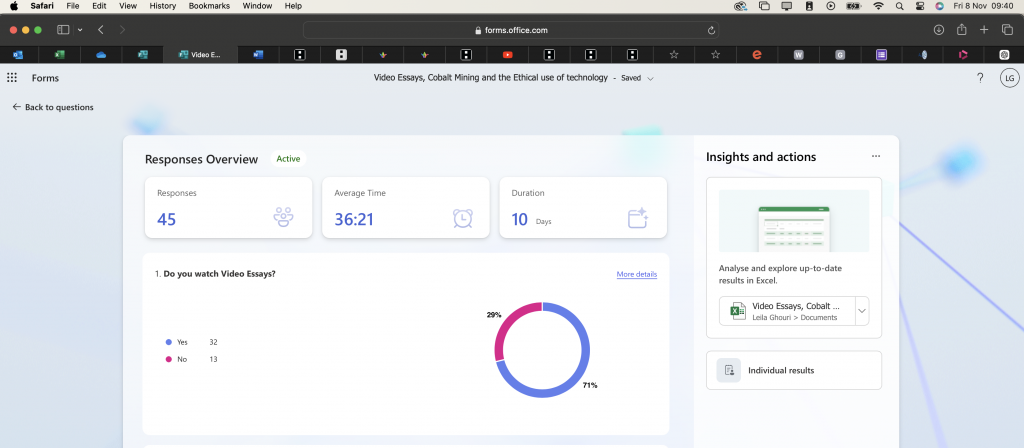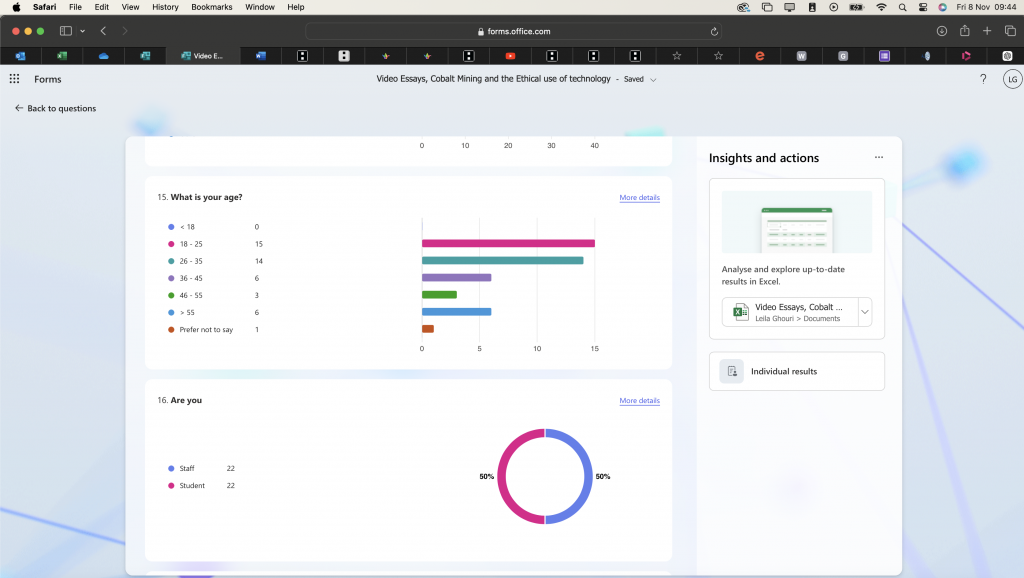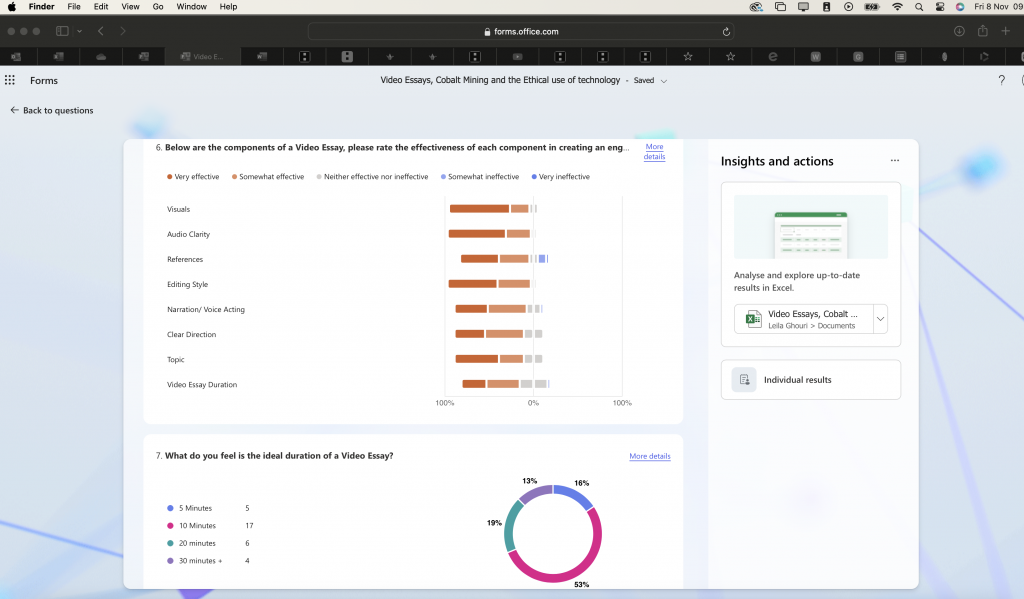Though my initial step was to create a a survey and send it out to staff and students, I still believe that my method is Art Based Action Research (ABAR) because my aim it to look at the data finding and then create a video essay based on those findings. That video essay would then be disseminated to the wider UAL community to help raise awareness on Cobalt Mining and challenge the current status quo.
Helen Kara’s Creative Research Methods in the Social Sciences (2022) significantly backs the design and methodology of my research on disseminating knowledge about Cobalt Mining’s environmental and human rights impacts. My research aims to assess the effectiveness of using a video essay as a medium for engaging students and staff at the University of the Arts London (UAL) on this pressing issue.
Methods such as visual art, filmmaking, and performance enable researchers to move beyond traditional academic formats, reaching audiences emotionally and intellectually, whilst also becoming more accessible. This aligns with my intention to use a video essay as a means of creative inquiry. By combining archival footage, data, and participatory insights, I aim to craft a narrative that informs and provokes critical reflection about the exploitation associated with cobalt mining, particularly in the Democratic Republic of Congo (DRC).
The use of filmmaking as a research tool resonates strongly with Kara’s (2022) emphasis on creativity in research. I agree with the point Kara makes, as innovative approaches help develop new perspectives and deeper engagement. By incorporating filmmaking, I hope to explore the intersections of environmental justice, human rights, and technology in a way that text-based formats might not achieve as text is not as accessible as video.
My survey design was influenced by three main aspects (Curtis and Curtis, 2011), I wanted to know what people ‘s attitudes were towards video essays, if people were aware of Cobalt Mining and their technology, once they were aware would they be willing to change their behaviour? I included minor attributional questions at the end to find out what field participants worked/studied in and weather they were staff or students. I didn’t believe it was necessary to ask about gender or race or anything else of that sort.
I selected the sample from UAL students that I am teaching, from 2 different courses MA Performance: Screen and BA Performance: Design and Practice. My Staff sample came from the my peers on the PGCert as well as the various departments at Central Saint Martins. I will use this sample to deduce what participants feel is the ideal setup for the video essay itself and find out about their awareness of cobalt mining in the DRC.
I launched my Survey this week and It has been promising so far. I have received answers from 45 people so far. (The duration of the questionnaire states 10 days, but that is 10 days since its official creation)

The Answers are totally anonymous, so I don’t know who’s who, however I have included a few non required questions which asks if the participant their age and role at UAL, to give better insight into the knowledge participants have and to pinpoint a knowledge gap if there is one. (If the numbers don’t match to the number of participants, please be aware that these questions are non-compulsory.)

Since this process of data gathering has started, I think it’s time for me to start planning the video essay. I’m also thinking about my presentation for January, since my peers and I will only have 10 minutes each I won’t be able to play the whole video essay, as currently the most popular video essay duration according to participants is 10 minutes.

I feel like both the form of my video essay as well as the content will be well informed by my participants. I think I will need to make a 30 second teaser as well as the video essay to keep within the time frame of my allotted time for presentation.
I plan to obtain verbal consent from participants rather than written consent. Given that the study is low-risk and maintains participant anonymity, I believe verbal consent will be sufficient and efficient. I’ll ensure that all participants are fully informed about the purpose of the study, their rights, and how their data will be used, following ethical guidelines. However, I’ll confirm with my institution’s ethics board to make sure this approach meets all necessary consent and documentation requirements.
My research forms itself as participatory, decolonised, and emancipatory research frameworks, which challenge systemic inequities, by addressing the intersection of cobalt mining and global inequalities. By engaging students and staff at UAL, my project seeks to build awareness of the hidden costs of the technology we use daily, thereby fostering a more critical and informed understanding of global justice issues.
This transformative framework also shapes my approach to storytelling within the video essay. By blending participatory insights and archival material, I aim to construct a narrative that not only informs but also inspires action. This interplay between the medium and the message enhances the impact of my research. The video essay becomes not just a tool for dissemination but also a statement on the ways we can critically engage with the technologies we take for granted.
References
Curtis, B., & Curtis, C. (2011). : survey research – studying many cases. In Social Research: A Practical Introduction (pp. 121-145). SAGE Publications, Inc., https://doi.org/10.4135/9781526435415
Curtis, B., & Curtis, C. (2011). : semiotic analysis – studying signs and meanings. In Social Research: A Practical Introduction (pp. 242-262). SAGE Publications, Inc., https://doi.org/10.4135/9781526435415
Kara, H. (2022) Creative Research Methods in the Social Sciences: A Practical Guide. 2nd edn. Bristol: Policy Press.